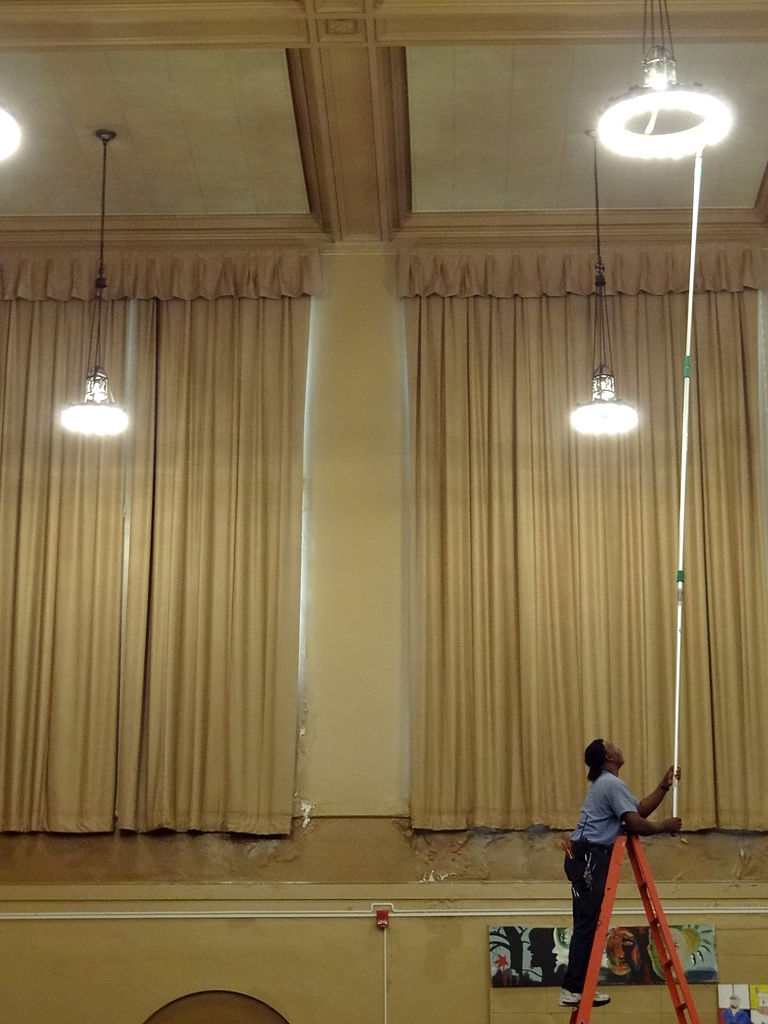Working with lighting maintenance contractors
Contents |
[edit] Introduction
Lighting maintenance contractors can be appointed to keep light fittings clean and change lamps regularly. Proper lighting maintenance also means that the correct lamps will continue to be used throughout the building’s lifetime.
In new buildings, proper maintenance can ensure that lighting satisfies the intention of the lighting designer. When properly executed, lighting maintenance measures in existing buildings can contribute to energy savings and more approriate light levels.
[edit] Relamping and cleaning
Lighting contractors should be required to provide planned maintenance. This establishes a framework for an effective maintenance programme, including regular relamping, cleaning and disposal.
By replacing lamps as their light output (but not their energy consumption) begins to decline, rather than waiting for them to fail, the lighting system should produce better average illuminance. This means that fewer lamps and fixtures are needed to maintain proper working conditions.
One approach to relamping is group relamping. This means changing all of the lamps at the same time on a scheduled basis. This practice consolidates labour and resources that would otherwise be required each time an individual lamp needed to be replaced.
Group relamping may be more cost effective when labour expenses are high and lamp costs are low. Cleaning can also be included during a group relamping, as labour will already be allocated.
Lighting maintenance contractors should be prepared to handle the proper disposal of materials. This should include recycling if possible.
[edit] Coordination between maintenance contractors and lighting designers
The installation of long life light sources will be important for lighting maintenance contractors when lights are installed in hard to reach locations. Lighting should also have accessible features and minimal components that can be easily removed for servicing. Maintenance will be more efficient when the number of lamp types in a building is minimised.
To assist with the maintenance process, lighting designers should be asked to provide a written maintenance policy, including recommended maintenance procedures and equipment replacement schedules. The design should reflect the intended level of maintenance to produce the correct light levels.
Contractors may be able to maintain lighting systems adequately, but this cannot prevent systems from becoming inefficient when modifications to a space create lighting conditions that are no longer suitable for the activities being performed. Lighting designers should be informed of significant changes made to the allocation of space within the building, and systems should be adjusted accordingly - both to maximise employee productivity levels and minimise wasted energy caused by misdirected lighting.
[edit] Related articles on Designing Buildings
Featured articles and news
A change to adoptive architecture
Effects of global weather warming on architectural detailing, material choice and human interaction.
How big is the problem and what can we do to mitigate the effects?
Overheating guidance and tools for building designers
A number of cool guides to help with the heat.
The UK's Modern Industrial Strategy: A 10 year plan
Previous consultation criticism, current key elements and general support with some persisting reservations.
Building Safety Regulator reforms
New roles, new staff and a new fast track service pave the way for a single construction regulator.
Architectural Technologist CPDs and Communications
CIAT CPD… and how you can do it!
Cooling centres and cool spaces
Managing extreme heat in cities by directing the public to places for heat stress relief and water sources.
Winter gardens: A brief history and warm variations
Extending the season with glass in different forms and terms.
Restoring Great Yarmouth's Winter Gardens
Transforming one of the least sustainable constructions imaginable.
Construction Skills Mission Board launch sector drive
Newly formed government and industry collaboration set strategy for recruiting an additional 100,000 construction workers a year.
New Architects Code comes into effect in September 2025
ARB Architects Code of Conduct and Practice available with ongoing consultation regarding guidance.
Welsh Skills Body (Medr) launches ambitious plan
The new skills body brings together funding and regulation of tertiary education and research for the devolved nation.
Paul Gandy FCIOB announced as next CIOB President
Former Tilbury Douglas CEO takes helm.
UK Infrastructure: A 10 Year Strategy. In brief with reactions
With the National Infrastructure and Service Transformation Authority (NISTA).
Ebenezer Howard: inventor of the garden city. Book review.
Airtightness Topic Guide BSRIA TG 27/2025
Explaining the basics of airtightness, what it is, why it's important, when it's required and how it's carried out.






















